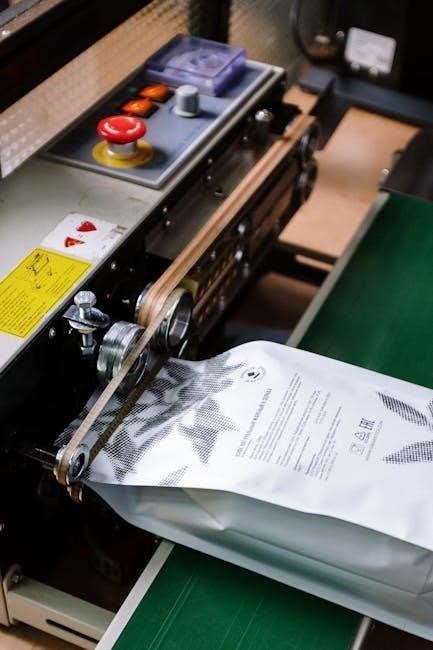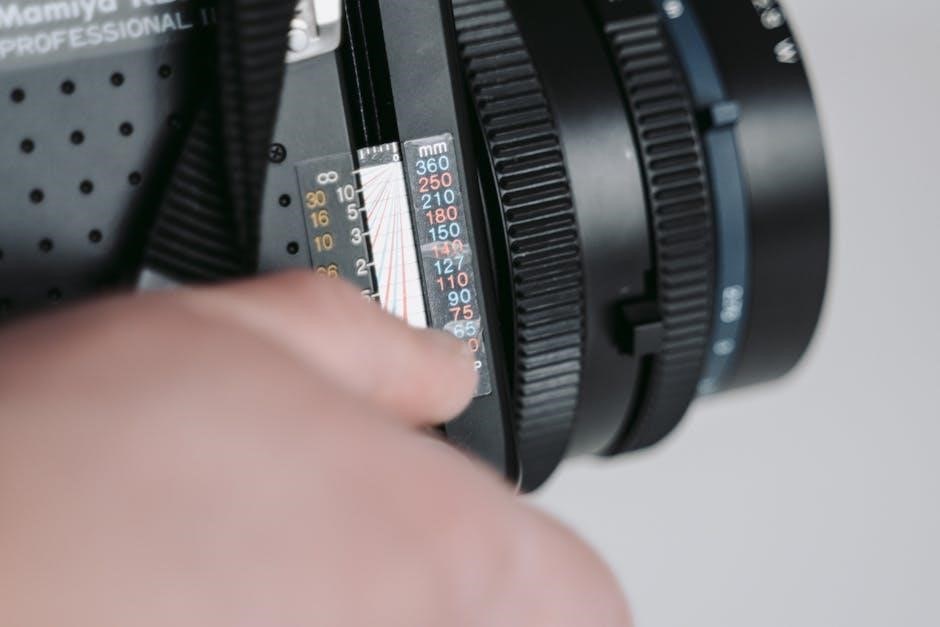Manual control involves human operation of systems‚ ensuring precision‚ reliability‚ and safety in engineering applications‚ particularly in robotics‚ automotive‚ and industrial automation.
1.1 Definition and Scope of Manual Control
Manual control refers to systems operated by human intervention‚ requiring hands-on interaction to achieve desired outcomes. It is fundamental in engineering‚ enabling precise adjustments and real-time decision-making. The scope of manual control spans various industries‚ including robotics‚ automotive‚ and industrial automation‚ where human oversight ensures safety and reliability. Unlike automated systems‚ manual control relies on operator expertise‚ making it essential for complex or unique tasks. Educational resources‚ such as control systems engineering manuals and courses‚ emphasize its importance. Professional certifications‚ like the PE exam‚ further highlight its relevance in modern engineering practices. Manual control remains a cornerstone in ensuring operational accuracy and adaptability across diverse applications.
1.2 Historical Development of Manual Control Systems
Manual control systems trace their origins to early mechanization‚ where human operators directly managed machinery. Over time‚ these systems evolved with advancements in engineering and technology. The integration of feedback mechanisms and precision instruments in the 20th century enhanced their efficiency. Today‚ manual control is integral to robotics‚ automotive systems‚ and industrial automation‚ ensuring reliability and adaptability. Resources like the Control Systems Engineering Exam Reference Manual and academic programs highlight its historical significance and modern applications. The development of these systems reflects continuous innovation‚ from basic mechanical controls to sophisticated interfaces‚ underscoring their enduring importance in engineering and technology.
1.3 Importance of Manual Control in Modern Engineering
Manual control remains vital in modern engineering due to its reliability and adaptability in complex systems. It provides direct human oversight‚ ensuring safety and precision in critical operations. Unlike automated systems‚ manual control allows for immediate intervention‚ reducing risks in unpredictable environments. In industries like aerospace and automotive‚ manual systems serve as fail-safes‚ complementing automated technologies. Additionally‚ manual control enables cost-effective solutions for simpler applications‚ avoiding unnecessary complexity. Its importance is further evident in training programs and certifications‚ highlighting its role in maintaining operational excellence. As technology advances‚ manual control continues to be an essential component‚ bridging the gap between human expertise and machine efficiency.

Principles of Manual Control Systems

Manual control systems rely on human operation‚ using principles like feedback‚ stability‚ and precision to maintain system performance. These systems integrate user input with mechanical components for effective control.
2.1 Open-Loop and Closed-Loop Control Systems
Manual control systems operate through two primary architectures: open-loop and closed-loop. Open-loop systems lack feedback mechanisms‚ relying on predefined inputs to achieve desired outputs. They are simple‚ cost-effective‚ and used in applications where precise control is not critical. Closed-loop systems‚ however‚ incorporate feedback to monitor and adjust outputs in real time‚ enhancing accuracy and stability. These systems are more complex but essential for applications requiring high precision‚ such as robotics or aerospace. The choice between open-loop and closed-loop depends on the specific requirements of the task‚ balancing factors like complexity‚ cost‚ and performance. Understanding these architectures is fundamental to designing effective manual control systems.
2.2 Feedback Mechanisms in Manual Control
Feedback mechanisms are essential in manual control systems‚ enabling operators to adjust their actions based on system outputs. Sensory feedback‚ such as visual‚ auditory‚ or tactile cues‚ allows individuals to monitor performance and make precise adjustments. In manual systems‚ feedback loops ensure that the operator can respond to deviations from desired outcomes. For instance‚ in steering systems‚ tactile feedback helps drivers sense vehicle responses. Effective feedback enhances accuracy‚ stability‚ and user confidence. It also reduces errors by providing real-time information‚ making it a critical component of both simple and complex manual control applications. Feedback mechanisms are integral to achieving optimal performance in manual systems.
2.3 Stability and Precision in Manual Systems
Stability and precision are crucial for effective manual control‚ ensuring systems operate consistently and accurately. Operator skill and experience significantly influence these aspects‚ as proficient control reduces deviations and enhances reliability. System design plays a vital role‚ with ergonomic interfaces minimizing errors and optimizing performance. Regular training and maintenance further contribute to stability‚ preventing unexpected fluctuations. However‚ human factors like fatigue and external disturbances can affect precision. To mitigate these‚ advanced tools and techniques are employed‚ such as real-time monitoring and adaptive aids‚ helping maintain control accuracy; Balancing these elements ensures manual systems achieve both stability and precision‚ essential for reliable operation across various applications.

Applications of Manual Control
Manual control is widely applied in manufacturing‚ robotics‚ aerospace‚ and automotive systems‚ ensuring precise operation and reliability in complex environments.
3.1 Industrial Automation and Manufacturing
In industrial automation and manufacturing‚ manual control systems play a crucial role in overseeing production processes‚ ensuring precision‚ and maintaining operational safety. These systems are often used to monitor and adjust machinery‚ allowing operators to intervene when automated processes require fine-tuning. Manual control is particularly essential in industries where human input is necessary for quality assurance‚ such as in assembly lines or custom manufacturing. By integrating manual oversight with automated workflows‚ manufacturers achieve a balance between efficiency and adaptability. This hybrid approach enables industries to address complex tasks‚ reduce errors‚ and optimize production cycles‚ making manual control indispensable in modern manufacturing environments.
3.2 Robotics and Mechatronics
In robotics and mechatronics‚ manual control systems are integral for precise operation and adaptability in dynamic environments. humanoid robots‚ for instance‚ rely on manual control to perform tasks requiring human intuition‚ such as handling delicate objects or navigating unpredictable terrains. In mechatronic systems‚ manual control enables operators to override automated functions when unforeseen challenges arise‚ ensuring safety and efficiency. This synergy between human input and machine autonomy enhances the capabilities of robotic systems‚ particularly in applications like assembly lines‚ medical robotics‚ and autonomous vehicles. By combining manual oversight with advanced automation‚ these systems achieve higher levels of accuracy and reliability in complex operations.
3.3 Aerospace and Defense Systems
Manual control plays a critical role in aerospace and defense systems‚ where precision and reliability are paramount. In aircraft navigation‚ pilots rely on manual controls to adjust flight trajectories and respond to unexpected conditions. Similarly‚ missile guidance systems often incorporate manual overrides to ensure accuracy and safety. Defense mechanisms‚ such as radar tracking and surveillance‚ benefit from manual adjustments to adapt to dynamic threats. Human intervention in these systems is essential for making split-second decisions‚ particularly in high-stakes environments. The integration of manual control with advanced automation enhances operational efficiency‚ ensuring mission success and safeguarding assets. This balance is vital in both military and space exploration applications.

3.4 Automotive Control Systems
Manual control is integral to automotive systems‚ enabling drivers to operate vehicles safely and efficiently. Steering wheels‚ pedals‚ and gearshifts are primary interfaces for manual control‚ allowing precise vehicle manipulation. Modern cars integrate manual controls with advanced systems‚ such as cruise control and adaptive braking‚ to enhance performance. Drivers rely on manual inputs for immediate responses‚ crucial in emergency situations. Additionally‚ manual controls provide a fallback option when automated systems fail. The balance between manual and automated control ensures driver confidence and system reliability. This dual approach is essential for navigating complex road conditions and maintaining safety standards in the automotive industry.

Education and Training in Manual Control
Education and training in manual control focus on developing skills in operating and maintaining control systems through academic programs‚ certifications‚ and hands-on training.
4.1 Academic Programs in Control Systems Engineering
Academic programs in control systems engineering provide foundational knowledge in manual control‚ offering degrees at undergraduate and postgraduate levels. These programs cover control theory‚ system dynamics‚ and automation. Students learn to design‚ analyze‚ and optimize control systems‚ focusing on stability‚ precision‚ and efficiency. Courses often include laboratory work‚ allowing hands-on experience with industrial-grade equipment. Many universities integrate manual control within broader engineering curricula‚ such as mechanical‚ electrical‚ or aerospace engineering. Specializations may include robotics‚ mechatronics‚ or process control‚ preparing graduates for roles in industries like manufacturing‚ aerospace‚ and automotive sectors. These programs emphasize both theoretical understanding and practical application‚ ensuring well-rounded skill development.
4.2 Certifications and Professional Licensing
Certifications and professional licensing play a crucial role in validating expertise in manual control systems. These credentials demonstrate a professional’s ability to design‚ implement‚ and maintain control systems safely and efficiently. Certifications like the Professional Engineer (PE) license are often required for high-level roles‚ particularly in industries like aerospace and automotive. Specialized certifications‚ such as those offered by the International Society of Automation (ISA)‚ focus on specific areas of control systems. These credentials enhance career prospects‚ ensure compliance with industry standards‚ and build trust with employers and clients. Staying certified requires ongoing education and adherence to professional development‚ ensuring practitioners remain updated on the latest technologies and methodologies in manual control.
4.3 Online Courses and Resources
Online courses and resources have become essential for mastering manual control systems‚ offering flexible learning opportunities. Platforms like Coursera‚ edX‚ and Udemy provide a wide range of courses on control systems engineering‚ covering topics such as control theory‚ system design‚ and practical implementation. Websites like IEEE and ISA offer tutorials‚ webinars‚ and certification programs tailored for professionals. These resources often include interactive simulations‚ case studies‚ and hands-on projects‚ enabling learners to apply theoretical knowledge in real-world scenarios. Additionally‚ online forums and communities‚ such as Reddit and LinkedIn groups‚ allow professionals to share experiences and solve challenges collaboratively. These resources are invaluable for both students and professionals seeking to enhance their skills in manual control systems.

Engineering Aspects of Manual Control Systems
Manual control systems require precise engineering to ensure reliability‚ scalability‚ and safety. Key aspects include system design‚ component selection‚ and integration of feedback mechanisms for optimal performance.
5.1 Hardware Components of Manual Control
The hardware components of manual control systems are essential for executing commands and maintaining system functionality. These include actuators‚ sensors‚ and control interfaces. Actuators convert control signals into physical actions‚ such as moving parts or adjusting settings. Sensors monitor system parameters‚ providing feedback for precise operations. Control interfaces‚ like joysticks or buttons‚ enable human interaction. Additionally‚ hydraulic‚ pneumatic‚ and electronic components are often integrated to ensure smooth operation. The hardware must be durable‚ reliable‚ and compatible with the system’s requirements. Proper selection and configuration of these components are critical for achieving desired performance‚ safety‚ and efficiency in manual control applications.
5.2 Software and Programming for Manual Systems
Software and programming play a crucial role in enhancing the functionality of manual control systems. Customized algorithms and programming languages‚ such as C++ or Python‚ are used to develop control logic and interfaces. Firmware integrates with hardware components‚ enabling precise command execution. User-friendly software tools‚ like graphical user interfaces (GUIs)‚ simplify operator interactions. Real-time operating systems (RTOS) ensure reliable and efficient processing of inputs and outputs. Programming also supports data logging‚ diagnostics‚ and system calibration. Advanced software features‚ such as simulation and modeling‚ aid in testing and optimizing manual control systems. Regular updates and maintenance of software ensure long-term performance and adaptability to evolving requirements.
5.3 Design and Implementation Best Practices
Designing and implementing manual control systems requires adherence to best practices to ensure reliability and efficiency. Start with a clear understanding of system requirements and user needs. Use modular design principles to allow scalability and ease of maintenance. Prioritize intuitive user interfaces to minimize operator errors. Implement iterative testing and validation to identify and resolve issues early. Ensure systems are fail-safe‚ with redundant mechanisms to handle unexpected conditions. Document all design decisions and processes for future reference. Conduct thorough training for operators and maintainers. Regularly review and update systems to adapt to new technologies or operational demands. Adhere to industry standards and regulations throughout the implementation process.

Safety and Reliability in Manual Control
Safety and reliability are critical in manual control systems to prevent accidents and ensure consistent performance. Implementing robust safety protocols minimizes operational risks and enhances system dependability‚ safeguarding both equipment and personnel while maintaining precise control over processes.
6.1 Risk Assessment and Mitigation
Risk assessment and mitigation are essential for ensuring the safety and reliability of manual control systems. By identifying potential hazards and evaluating their likelihood and impact‚ operators can implement targeted strategies to minimize risks. Common risks in manual control include human error‚ equipment failure‚ and environmental factors. Mitigation involves designing fail-safe mechanisms‚ providing operator training‚ and regularly maintaining equipment. Effective risk management also includes ongoing monitoring and updating of safety protocols to adapt to new challenges. Proactive approaches ensure that manual control systems operate reliably‚ reducing the probability of accidents and enhancing overall performance.
6.2 Fail-Safe Mechanisms in Manual Systems
Fail-safe mechanisms are critical components of manual control systems‚ ensuring that operations remain safe even when component failures occur. These mechanisms are designed to default to a safe state‚ preventing accidents and minimizing downtime. In manual systems‚ fail-safes often involve redundant components‚ emergency shutdowns‚ and automatic resets. For instance‚ in industrial applications‚ a fail-safe mechanism might automatically shut off machinery if a critical parameter exceeds safe limits. These designs prioritize operator and system safety‚ reducing the risk of human error and equipment malfunction. Implementing fail-safe mechanisms enhances reliability and ensures that manual control systems can operate securely under various conditions.
6.3 Maintenance and Troubleshooting
Maintenance and troubleshooting are essential for ensuring the reliability and efficiency of manual control systems. Regular maintenance involves inspecting and replacing worn components‚ lubricating moving parts‚ and verifying sensor accuracy. Troubleshooting requires identifying and addressing issues promptly to minimize downtime. Technicians use diagnostic tools and systematic approaches to trace faults‚ such as checking wiring‚ testing sensors‚ and analyzing error codes. Proper documentation and training are crucial for effective troubleshooting. Preventative maintenance schedules help anticipate and resolve potential problems before they escalate. By combining proactive maintenance with skilled troubleshooting‚ manual control systems can operate smoothly‚ ensuring safety and productivity in various applications.

Case Studies in Manual Control
Real-world applications of manual control systems demonstrate their effectiveness in industries like manufacturing‚ aerospace‚ and automotive‚ highlighting improved efficiency and reduced operational errors through precise control strategies.
7.1 Real-World Applications and Success Stories
Manual control systems have proven instrumental in various industries‚ showcasing their effectiveness in improving efficiency and reducing operational errors. In manufacturing‚ manual control has optimized production lines‚ ensuring precise assembly and quality control. Aerospace systems rely on manual overrides for critical adjustments during flights‚ enhancing safety and performance. Automotive industries use manual control for precise steering and braking systems‚ improving driver control. Case studies highlight how manual control integrated with automation has led to significant advancements. For instance‚ in robotics‚ manual control enables precise movements in surgical robots‚ revolutionizing healthcare. These success stories underscore the versatility and reliability of manual control systems in diverse applications.
7.2 Lessons Learned from Manual Control Projects
Manual control projects have revealed critical insights into system design and operation. One key lesson is the importance of balancing human intuition with automated processes to ensure reliability. Projects have shown that over-reliance on manual control can lead to errors‚ while neglecting human oversight risks system failures. Training and maintenance are paramount to maintain performance. Additionally‚ integrating feedback mechanisms early in design improves responsiveness and accuracy. Case studies highlight the need for robust fail-safe protocols to mitigate risks. These lessons emphasize the importance of adaptability and continuous improvement in manual control systems. By addressing these challenges‚ engineers can enhance system efficiency and reliability.

Future Trends in Manual Control
Technological advancements are transforming manual control systems‚ emphasizing integration with AI‚ IoT‚ and smart technologies. Future trends include enhanced human-machine collaboration‚ predictive maintenance‚ and adaptive control solutions.
8.1 Integration with Artificial Intelligence
The integration of artificial intelligence (AI) with manual control systems is revolutionizing how humans interact with technology. AI enhances decision-making by analyzing real-time data‚ enabling predictive actions and optimizing system performance. Machine learning algorithms improve precision‚ reducing human error in complex tasks. AI-driven interfaces adapt to user behavior‚ streamlining control processes. This synergy boosts efficiency in industries like manufacturing and aerospace‚ where manual operations require high accuracy. AI also supports safety by identifying potential failures and assisting operators in critical scenarios. As AI evolves‚ it promises to create smarter‚ more intuitive manual control systems‚ blending human expertise with technological advancements for enhanced reliability and productivity.
8.2 Advancements in IoT and Smart Systems
Advancements in the Internet of Things (IoT) and smart systems are transforming manual control by enabling seamless connectivity and real-time data exchange. IoT devices integrate sensors‚ actuators‚ and control interfaces‚ enhancing precision and responsiveness. Smart systems leverage data analytics to optimize performance‚ reducing human error and improving efficiency. These technologies enable remote monitoring and control‚ allowing operators to manage systems from anywhere. IoT also supports condition-based maintenance‚ ensuring optimal system health. In industries like manufacturing and automotive‚ smart systems enhance safety and productivity. The convergence of IoT and manual control creates adaptive‚ scalable solutions‚ driving innovation and reshaping traditional control methodologies for modern applications.
8.3 Predictive Maintenance and Adaptive Control
Predictive maintenance and adaptive control are revolutionizing manual control systems by leveraging advanced algorithms and real-time data. Predictive maintenance uses sensor data and machine learning to forecast equipment failures‚ enabling proactive repairs and minimizing downtime. Adaptive control systems adjust their behavior dynamically based on changing conditions‚ ensuring optimal performance. These technologies enhance manual control by reducing human intervention in routine tasks while improving accuracy. In industrial and automotive applications‚ predictive maintenance reduces operational costs and increases safety. Adaptive control ensures systems remain stable and efficient‚ even in unpredictable environments. Together‚ these advancements are redefining manual control‚ making it smarter‚ more reliable‚ and aligned with Industry 4.0 standards.
Manual control remains vital in engineering‚ providing precise command and adaptability in systems requiring human oversight‚ ensuring efficiency and safety across various industries.
9.1 Summary of Key Concepts
Manual control systems rely on human operation‚ emphasizing precision and adaptability in dynamic environments. They are fundamental in industries like aerospace‚ automotive‚ and industrial automation‚ where real-time decision-making is crucial. The principles of open-loop and closed-loop systems‚ along with feedback mechanisms‚ ensure stability and accuracy; Historical advancements have refined manual control‚ integrating it with modern technologies. Education and training are essential for mastering these systems‚ while safety and reliability remain paramount. Future trends highlight the integration of AI and IoT‚ enhancing efficiency. Balancing traditional methods with innovation‚ manual control continues to be indispensable in engineering‚ offering a unique blend of human expertise and technological advancement.
9.2 Future Outlook for Manual Control Systems
The future of manual control systems is poised for transformation‚ driven by advancements in technology and evolving industry demands. Integration with artificial intelligence and IoT will enhance real-time decision-making and precision. Predictive maintenance and adaptive control systems are expected to reduce downtime and improve efficiency. As automation advances‚ the role of human operators will shift toward overseeing complex systems rather than performing repetitive tasks. Sustainability and energy efficiency will also shape the development of manual control systems. Engineers will need to adapt to these changes‚ ensuring seamless interaction between human expertise and intelligent technologies. This synergy will drive innovation‚ making manual control systems more versatile and essential in the digital age.

